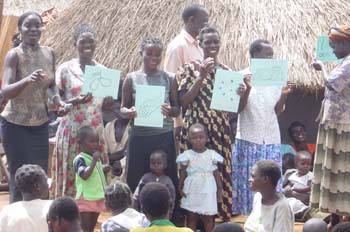Emergency Community Health Clubs
Emergency Community Health Clubs (eCHC)
Introduction
Traumatised people can support each other as a group by become community volunteers in Emergency Community Health Clubs (eCHC) coordinating themselves effectively to improve WASH practices in the area, through shared knowledge and understanding, resulting in positive hygiene behaviour change and social capital.
Case Studies
In Northern Uganda (2002) 89% of the population had fled from their villages to live in 33 Internally Displaced People’s (IDP) Camps in Gulu District. 25 clinicians from a local NGO, were trained as CHC facilitators, and posted in 15 IDPs camps. They started 116 Community Health Clubs and mobilized a total of 15,522 regular members (42% of the 36,138 households) who met weekly for 25 hygiene sessions over six months. Prior to this intervention latrine coverage was only 5% – with open defecation being so dense around the perimeter of the camp that guards found it off-putting to patrol. After only 4 months, health club members had themselves constructed 8,504 latrines, as well as 6,020 bath shelters, 3,372 drying racks, and 1,552 hand washing facilities, with an estimated 100,000 direct beneficiaries at <US$5 per person. The CHC model was successfully replicated in Pader District. (Waterkeyn, Okot & Kwame. 2005)
Programmes
Publications
Waterkeyn. J., Okot. & P, Kwame. V. (2005) Rapid Sanitation Uptake in the Internally Displaced People Camps of Northern Uganda through Community Health Clubs. 31st WEDC Conference, Kampala. https://wedc-knowledge.lboro.ac.uk/resources/conference/31/WaterkeynJ.pdf


